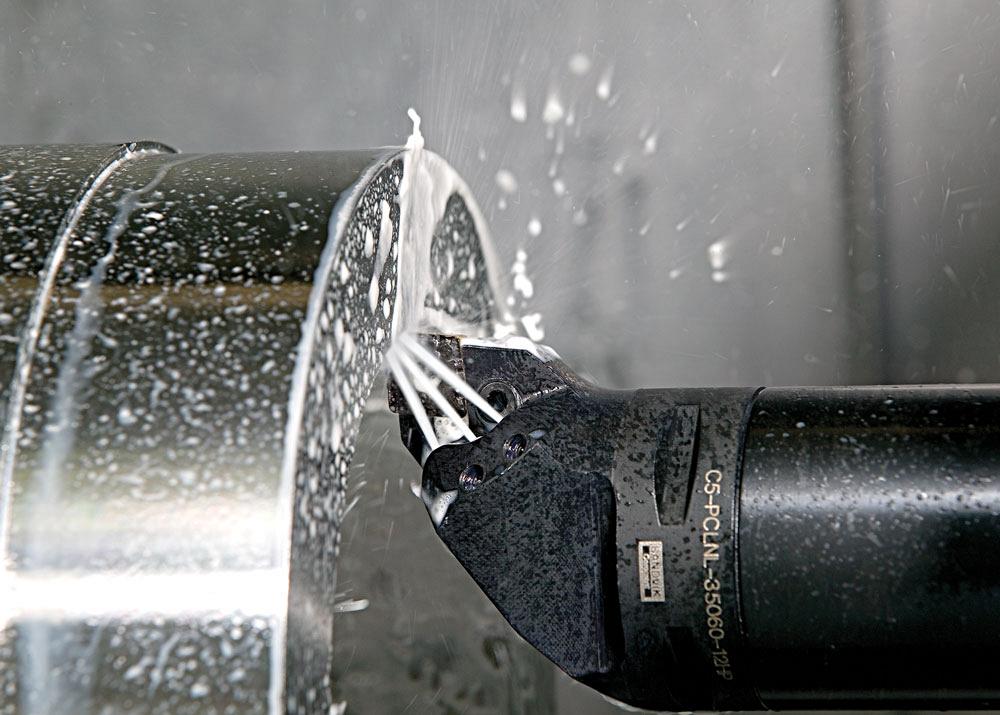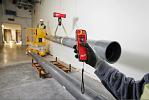Editor
- FMA
- The Fabricator
- FABTECH
- Canadian Metalworking
When do you run uncoated?
A sharp, strong cutting edge is essential when turning aluminum
- By Joe Thompson
- February 10, 2020
- Article
- Cutting Tools

While built-up edge is the most common wear criteria for aluminum, flank wear [occurs] in higher-abrasive materials, such as high-silicon aluminum. Photo courtesy of Sandvik Coromant Canada.
There is one no right way to cut metal. Many options exist depending on part size, features, and cutting method. When the operation involves turning aluminum, two good choices are polycrystalline diamond (PCD) tooling and an uncoated insert with a strong, sharp cutting edge.
Aluminum and BUE
Aluminum is a gummy material that quickly causes built-up edge (BUE) on an insert. It’s also an abrasive material that breaks down the cutting edge prematurely when run at high RPMs or high surface feeds. But, if the tooling and parameters are matched, it is an easy-cutting material.
Built-up edge is the primary mode of failure in aluminum machining. The molten/softened aluminum tends to form blobs of built-up material on the cutting edge, which dulls the cutting edge, thereby reducing the shearing action and exacerbating the buildup to the point that a chunk of carbide edge is pulled away as the BUE breaks free from the cutting edge. This leads to tool failure and shortened tool life.
Because the best way to machine aluminum is to “shear” it, a sharp cutting edge with excellent shearing action is required. In terms of the insert’s geometry, this means that a very positive rake angle with a very sharp cutting edge is the best. This sharp edge helps avoid the problem of BUE.
Coated inserts
“An insert with a very smooth coating and a mirror-like surface finish usually prevents the phenomenon of built-up edge, or at least reduces it. This leads to a direct increase in tool life,” said Sarang Garud, product manager, marketing at Walter USA. “A smooth coating with a mirror-like surface finish also leads to effective chip evacuation as well because the chips tend to flow freely over the rake face of the insert.”
Such a coating is Walter’s WNN10, which has a fine-grain carbide substrate and a dense yet thin (2 µm) TiAlN coating deposited via the physical vapor deposition (PVD) process.
“The deposition process is called HIPIMS [high-power impulse magnetron sputtering], and this leaves a very thin PVD layer, which has a surface finish that is orders of magnitude better than the standard PVD process. This leads to a very smooth chip evacuation, reduced built-up edge, and a tool life that can be even double the standard uncoated carbide in some cases,” said Garud.
It is also possible to use other coatings when turning aluminum, such as diamond-like carbon (DLC) coating, which, according to Garud, mimics the properties of the diamond from a PCD tool.
“Such coatings are also very smooth and extremely hard and have the same benefits of reducing built-up edge and increasing tool life. We use this coating on our replaceable tip drilling inserts (also called point drills),” he explained.
Uncoated inserts
Uncoated inserts have a much sharper edge, which is why they are a good choice for cutting aluminum.
“Ideally, aluminum can be machined with uncoated, polished inserts or PCD inserts if the silicon content is high,” said Garud. “Uncoated inserts have the advantage of preserving edge sharpness, and the sharpest edge (up sharp) is preferred to machine it.”
“Any coated insert will have an edge rounding, even minute with PVD, but still slightly negative compared to an uncoated insert,” said Kevin Burton, product specialist, Sandvik Coromant Canada.
For aluminum alloys with a silicon content above 13 per cent, PCD tooling should be used because the tool life of cemented carbide grades is drastically reduced in those alloys. The material can be machined with fine-grained, uncoated carbide grades when the silicon content is below 7 to 8 per cent, and with PCD-tipped grades for aluminum with higher silicon content.
Uncoated tools have less wear resistance in these higher-silicon aluminums, he said. They also have a different wear mechanism.
“While built-up edge is the most common wear criteria for aluminum, flank wear [occurs] in higher-abrasive materials, such as high-silicon aluminum,” he said.
The importance of coolant
A proper coolant strategy is important when cutting aluminum. Coolant in aluminum machining is mostly used for chip evacuation and, obviously, lubricity.
“High-precision/-pressure coolant is a good choice,” said Burton. “This coolant strategy prevents smearing and built-up edge.”
According to Burton, Sandvik’s H10 uncoated carbide grade combines good abrasive wear resistance with edge sharpness for roughing to finishing of aluminum alloys.
Editor Joe Thompson can be reached at jthompson@canadianmetalworking.com.
Sandvik Coromant Canada, www.sandvik.coromant.com
Walter, www.walter.com
About the Author

Joe Thompson
416-1154 Warden Avenue
Toronto, M1R 0A1 Canada
905-315-8226
Joe Thompson has been covering the Canadian manufacturing sector for more than two decades. He is responsible for the day-to-day editorial direction of the magazine, providing a uniquely Canadian look at the world of metal manufacturing.
An award-winning writer and graduate of the Sheridan College journalism program, he has published articles worldwide in a variety of industries, including manufacturing, pharmaceutical, medical, infrastructure, and entertainment.
Related Companies
subscribe now


Keep up to date with the latest news, events, and technology for all things metal from our pair of monthly magazines written specifically for Canadian manufacturers!
Start Your Free Subscription- Industry Events
ZEISS Quality Innovation Days 2024
- April 15 - 19, 2024
Tube 2024
- April 15 - 19, 2024
- Düsseldorf, Germany
CTMA Economic Uncertainty: Helping You Navigate Windsor Seminar
- April 30, 2024
- Windsor, ON Canada
MME Winnipeg
- April 30, 2024
- Winnipeg, ON Canada
CTMA Economic Uncertainty: Helping You Navigate Kitchener Seminar
- May 2, 2024
- Kitchener, ON Canada




















